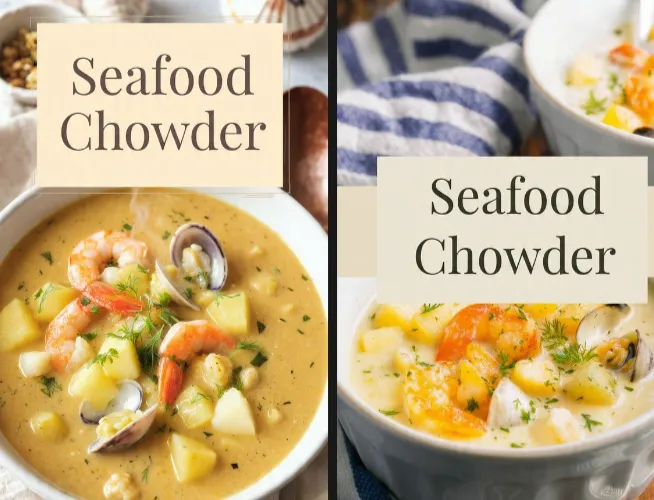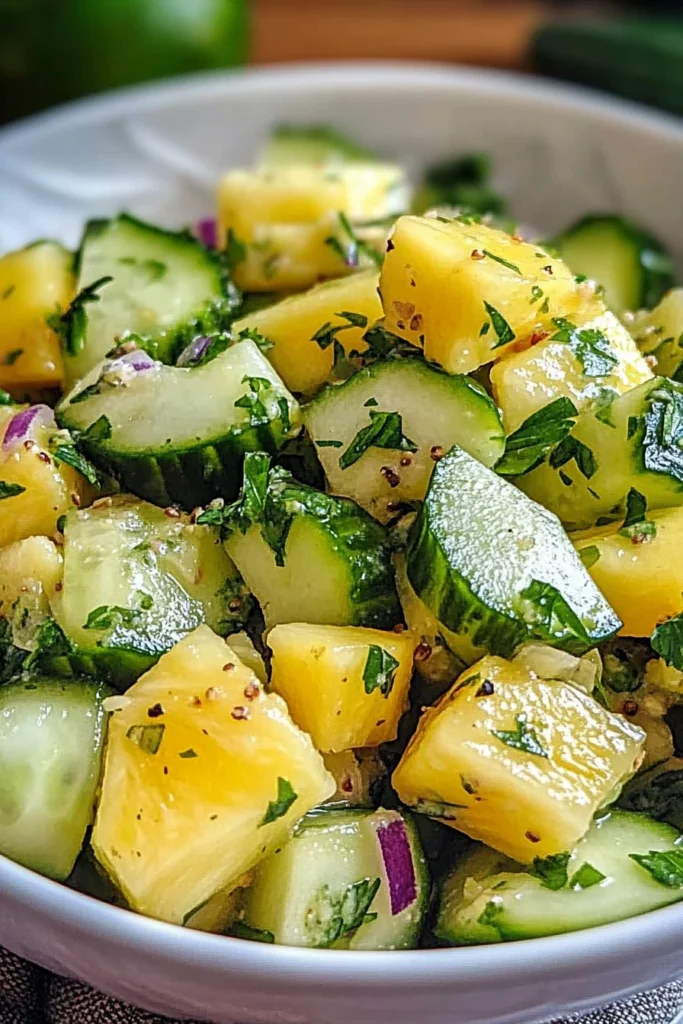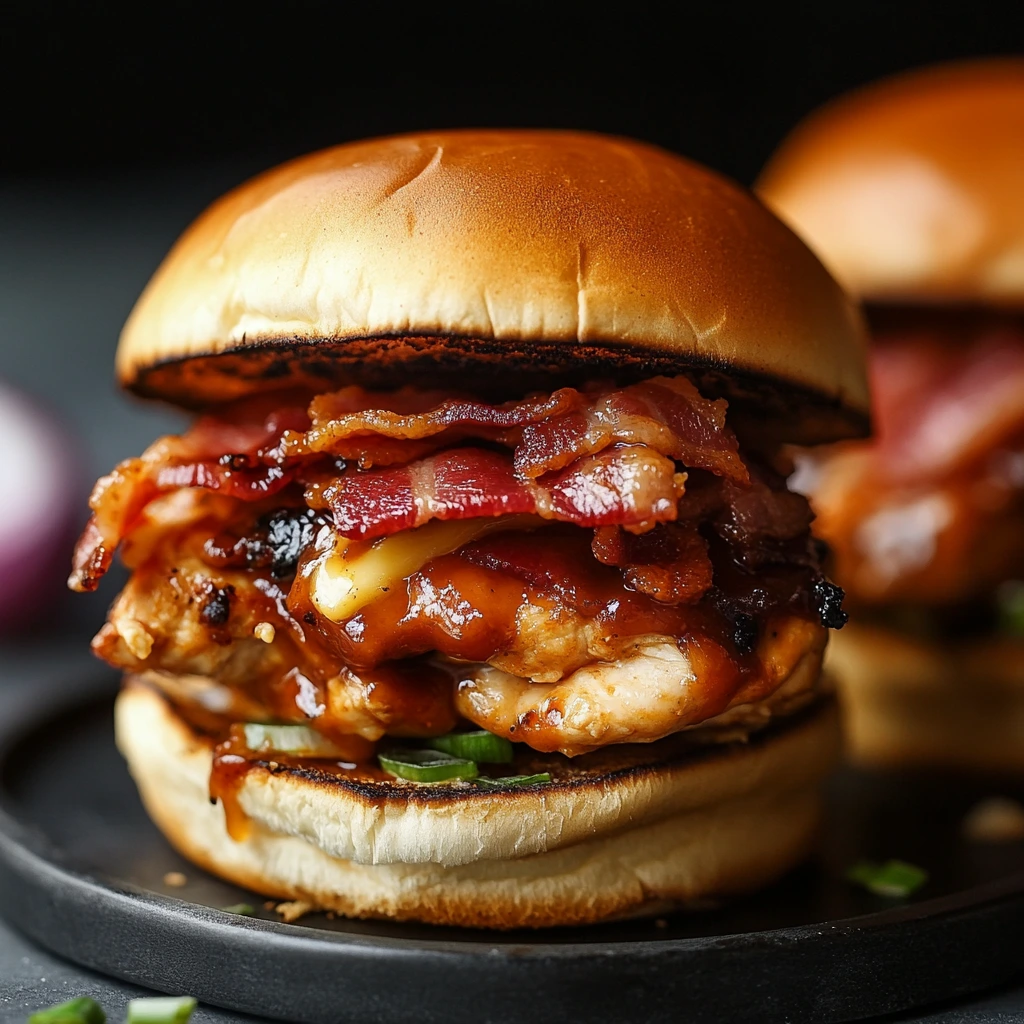Seafood Chowder is a creamy, hearty soup that brings the flavors of the ocean straight to the table. Loaded with tender fish, shrimp, and potatoes, it’s rich, comforting, and deeply satisfying. Each spoonful is a perfect balance of creamy broth, delicate seafood, and aromatic vegetables. Whether served as a main course or a starter, this chowder is a timeless dish that warms the soul and delights the senses. This recipe celebrates the best of coastal cooking — simple ingredients transformed into something extraordinary. The combination of fresh seafood, cream, and herbs creates a luxurious texture and flavor that’s both rustic and refined. It’s perfect for chilly evenings, family dinners, or festive gatherings.
The essence of Seafood Chowder lies in its creamy base and the freshness of the seafood. The broth is rich but not heavy, infused with the natural sweetness of shellfish and the earthiness of potatoes. The vegetables add depth, while the herbs and cream tie everything together into a smooth, velvety finish.
This recipe works because it builds flavor in layers. The vegetables are sautéed to release their sweetness, the seafood is gently simmered to preserve its tenderness, and the cream adds richness without overpowering the delicate flavors. The result is a chowder that’s perfectly balanced — creamy, savory, and full of texture.
Ingredients and Their Roles
Seafood mix: A combination of fish, shrimp, scallops, or clams adds variety and depth. Potatoes: Provide body and heartiness. Onion, celery, and carrots: Form the aromatic base. Butter: Adds richness and helps sauté the vegetables. Flour: Thickens the chowder. Fish or seafood stock: Creates a flavorful base. Cream or milk: Adds smoothness and richness. Bay leaf and thyme: Infuse the chowder with subtle herbal notes. Salt and pepper: Enhance and balance the flavors. Parsley or chives: Add freshness at the end.
Step-by-Step Recipe
Ingredients (serves 4–6)
2 tbsp butter 1 tbsp olive oil 1 onion, finely chopped 2 celery stalks, diced 1 carrot, diced 2 cloves garlic, minced 2 tbsp flour 4 cups fish or seafood stock 2 medium potatoes, peeled and cubed 1 bay leaf ½ tsp dried thyme 1 cup heavy cream or milk 300 g white fish (cod, haddock, or halibut), cut into chunks 200 g shrimp, peeled and deveined 150 g scallops or clams (optional) Salt and black pepper to taste Fresh parsley or chives for garnish
Preparation
In a large pot, melt butter with olive oil over medium heat. Add onion, celery, and carrot. Cook for 5–7 minutes until softened. Add garlic and cook for another minute. Sprinkle flour over the vegetables and stir to coat. Cook for 1–2 minutes to remove the raw flour taste. Gradually pour in the fish stock while stirring. Add the potatoes, bay leaf, and thyme. Bring to a boil, then reduce heat and simmer for 15 minutes until the potatoes are tender. Gently add the fish, shrimp, and scallops. Simmer for 5–7 minutes until the seafood is cooked through. Stir in the cream and season with salt and pepper. Simmer gently for 5 minutes more, but do not boil. Remove the bay leaf, ladle into bowls, and garnish with fresh parsley or chives. Serve hot with crusty bread.
Tips for the Perfect Seafood Chowder
Use fresh seafood for the best flavor. Don’t overcook the seafood — it should be tender, not rubbery. Add cream at the end to prevent curdling. Adjust thickness by adding more stock or cream. Serve immediately for the freshest taste.
Variations and Flavor Combinations
Classic New England Seafood Chowder: Traditional version with cream, potatoes, and mixed seafood. Tomato-Based Seafood Chowder: Add crushed tomatoes and paprika for a Manhattan-style twist. Spicy Cajun Seafood Chowder: Add Cajun seasoning and a dash of hot sauce for heat. Corn and Seafood Chowder: Add sweet corn kernels for extra texture and sweetness. Smoked Fish Chowder: Use smoked haddock or salmon for a rich, smoky flavor. Coconut Seafood Chowder: Replace cream with coconut milk for a tropical, dairy-free version.
Serving Suggestions
Seafood Chowder pairs beautifully with crusty bread or garlic toast, oyster crackers or croutons, fresh green salad, roasted vegetables, or steamed greens. It’s perfect for cozy winter dinners, family gatherings, holiday feasts, and weekend lunches.
Make-Ahead and Storage
Make-ahead: Prepare the base (without seafood) up to 2 days in advance. Add seafood and cream just before serving. Storage: Store leftovers in the refrigerator for up to 2 days. Freezing: Not recommended due to the cream and seafood texture. Reheating: Reheat gently over low heat, stirring occasionally. Do not boil.
Nutritional Information (per serving)
Calories: 380 kcal Protein: 28 g Fat: 22 g Carbohydrates: 18 g Sugar: 4 g
The History of Chowder
Chowder originated in coastal regions of Europe and North America, where fishermen combined their catch with potatoes, onions, and cream to create hearty stews. The word “chowder” comes from the French “chaudière,” meaning cauldron. Over time, regional variations emerged — from creamy New England chowders to tomato-based Manhattan versions. Seafood Chowder remains a beloved classic, symbolizing comfort and coastal tradition.
Texture and Flavor Profile
The perfect Seafood Chowder is creamy, rich, and full of texture. The potatoes provide body, the seafood adds sweetness and depth, and the cream ties everything together. The broth should be smooth but not heavy, with a balance of savory and oceanic flavors. Each spoonful offers a mix of tender seafood, soft vegetables, and velvety broth.
Common Mistakes and How to Avoid Them
Overcooked seafood: Add seafood at the end and cook gently. Curdled cream: Avoid boiling after adding cream. Watery chowder: Use the right ratio of flour and stock. Bland flavor: Season in layers and use a good-quality stock. Too thick: Thin with extra stock or milk.
Chef’s Tips
Deglaze the pot with a splash of white wine for extra depth. Add a few drops of lemon juice before serving to brighten the flavor. Use a mix of seafood for variety in texture and taste. Garnish with crispy bacon bits for a smoky touch. Serve in warm bowls to keep the chowder hot longer.
Pairing Ideas
With Drinks: Pair with Chardonnay or Sauvignon Blanc, light beer or cider, or sparkling water with lemon. With Food: Serve alongside seafood platters or grilled fish, roasted potatoes or corn on the cob, or a fresh baguette or sourdough bread.
The Joy of Coastal Cooking
Seafood Chowder embodies the joy of coastal cooking — fresh ingredients, simple techniques, and comforting flavors. It’s a dish that connects land and sea, tradition and comfort. The process of simmering, stirring, and tasting is as rewarding as the final bowl itself.
The Science of Creamy Chowder
The creaminess of chowder comes from the combination of starch and fat. The potatoes release starch as they cook, thickening the broth naturally. The flour in the roux stabilizes the mixture, while the cream adds richness and smoothness. The key is gentle heat — enough to meld the flavors without breaking the emulsion.
Presentation and Finishing Touches
For a beautiful presentation, ladle the chowder into bowls and top with a sprinkle of herbs, a drizzle of cream, or a few whole shrimp. Serve with toasted bread or oyster crackers for texture. For a restaurant-style touch, add a swirl of herb oil or a pinch of smoked paprika.
Modern Variations
Keto Version: Skip the flour and use heavy cream for thickness. Gluten-Free Version: Use cornstarch instead of flour. Vegan Version: Use coconut milk and plant-based seafood alternatives. Low-Calorie Version: Use milk instead of cream. Gourmet Version: Add lobster or crab meat for luxury.
The Perfect Bite
The perfect bite of Seafood Chowder is creamy, savory, and full of ocean flavor. The tender seafood melts in the mouth, the potatoes add comfort, and the herbs bring freshness. It’s a bite that feels both indulgent and wholesome — the essence of coastal comfort food.
Conclusion
Seafood Chowder is creamy, hearty, and full of ocean flavor — a timeless dish that brings warmth and comfort to any table. With its rich broth, tender seafood, and velvety texture, it’s perfect for cozy dinners, family gatherings, or festive occasions. Easy to make and endlessly adaptable, it celebrates the freshness of the sea and the comfort of home cooking. This recipe proves that with simple ingredients and a touch of care, you can create a dish that’s both comforting and unforgettable — a true classic that never goes out of style.







